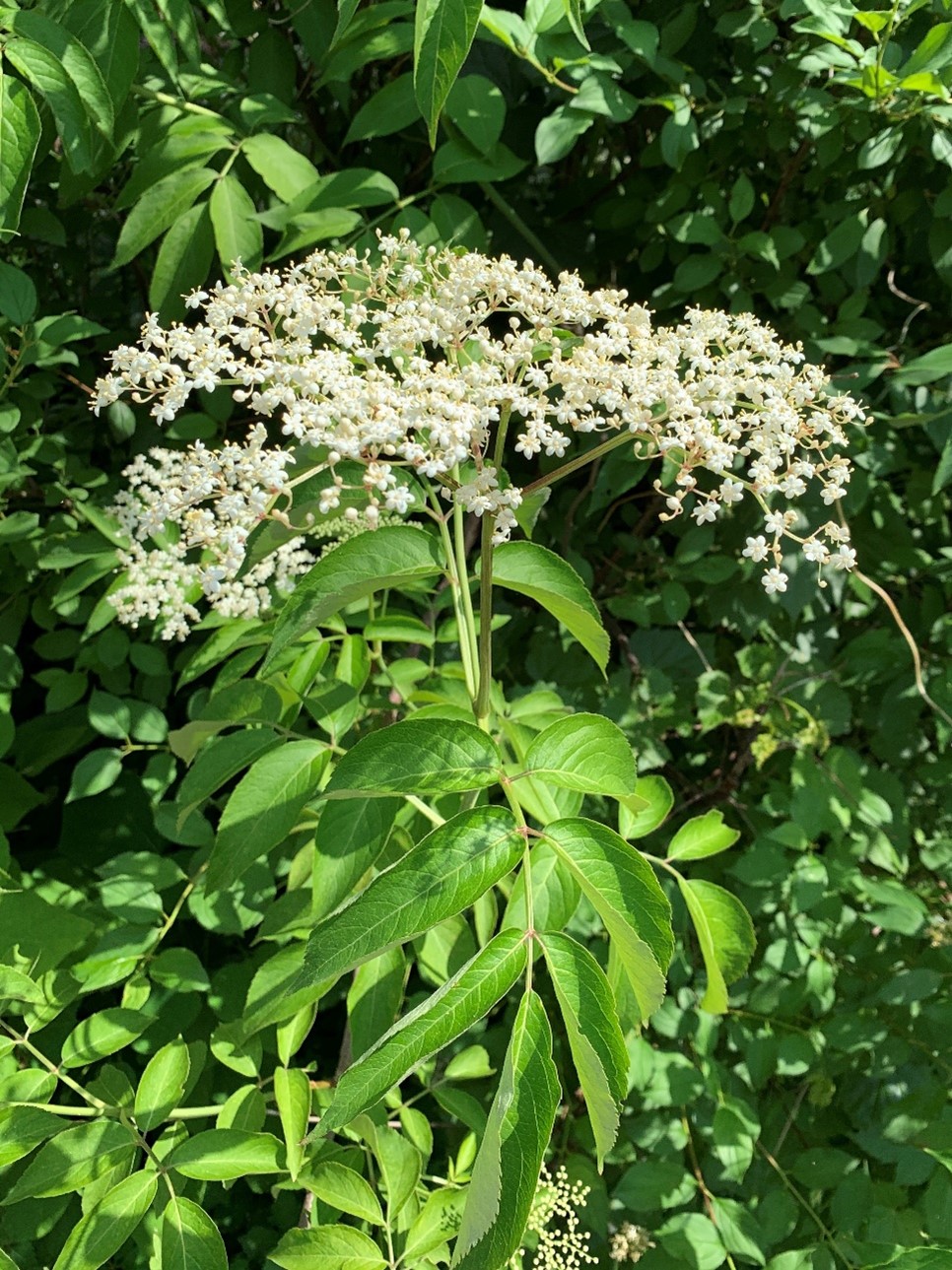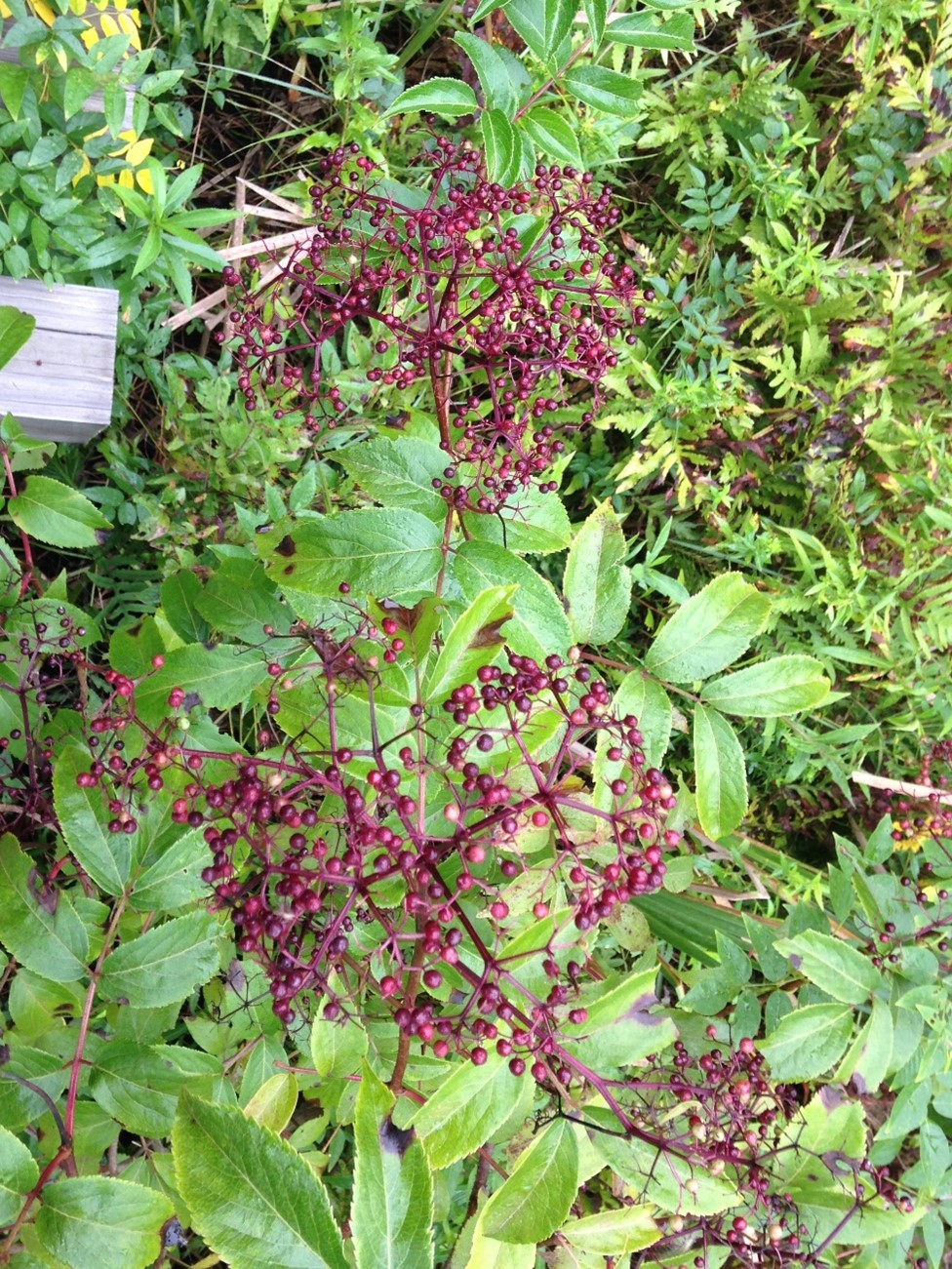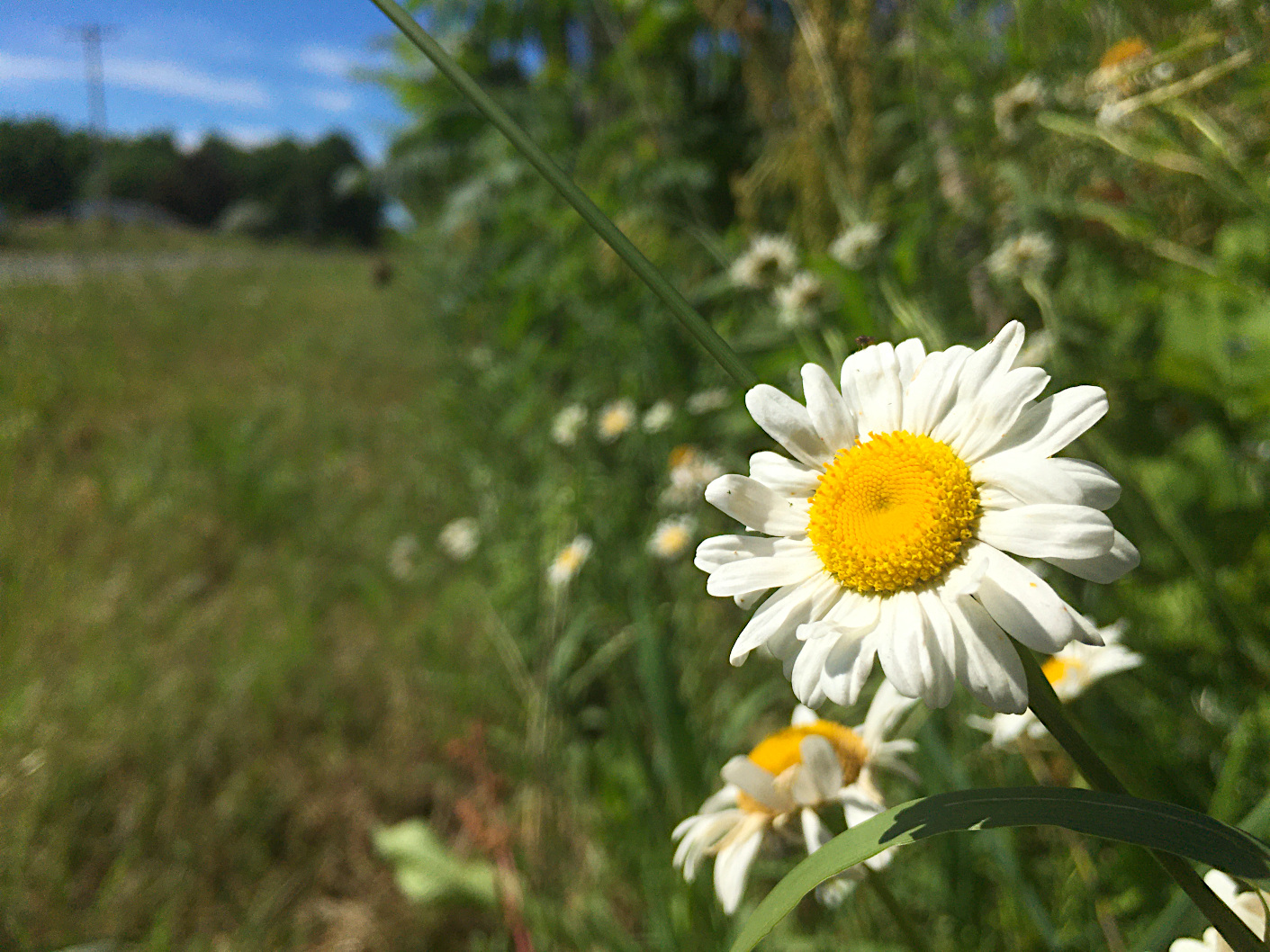Drive-by botany: Elderberry and ox-eye daisy
Profiles of common Michigan roadside flora in late June 2022.

Authors’ note: Drive-by Botany is a continuing series that highlights flowering plants commonly seen from the road. As a service to new readers, we include the introduction with each article. If you're already familiar with the premise, feel free to skip down to the good stuff.
Has a patch of flowers ever caught your eye as you travelled down the road? It certainly happens to us all the time! As gardeners and naturalists, we're always interested increasing functional diversity in our gardens and landscapes, so we thought it would be fun to consider some of the roadside plants that we see every day. Each article in this series will feature two plant species that are currently blooming and frequently observed from the road. Our goal is to answer two simple questions:
- What are they?
- Would they make good garden plants?
As part of the process, we'll include some biological tidbits and a few useful characteristics for identification. Please note that some of the plants we feature are exotic invasive species; we'll be sure to include recommendations from land management professionals on how to manage them in your landscape.
June 2022 - week 26, growing degree days (GDD) 2,186 base 32 F, East Lansing, Michigan
Elderberry (Sambucus canadensis)
Synonyms: common elder, American elder
Common elderberry is a large, multi-stemmed shrub. It is a native species that can grow up to 12 feet tall and 10 feet wide. This species grows quickly and forms colonies via root suckers (similar to sumac). It tolerates a wide range of conditions, and can be seen growing on the roadside, forest borders, or in marshes and meadows. Common elderberry is happiest in wet soil. In summer, it produces white clusters of flowers that eventually give way to deep purple fruit by the end of summer. The berries are a popular food for humans (when cooked) and birds alike.
Description
Flowers: Common elderberry produces clusters of white flowers. The clusters range from 3 to 10 inches across, and the individual flowers are about 0.25 inch across. They have five rounded petals.
Leaves: Leaves are pinnately compound, usually with seven leaflets per leaf. The leaves are oppositely arranged along the stem. Leaflets are lance-shaped, have finely serrated margins and a pointed tip. They may also be hairless or slightly hairy along the midvein.
Stems: Young stems are usually hairless with noticeable lenticels (raised pores used for gas exchange). Older stems have a brown/grey bark that becomes more fissured with age. The shrub itself has multiple main stems, which do not usually get larger than 3 inches in diameter.

Seeds/fruit: Common elderberry produces beautiful berries that ripen by late August. The berries start off green and become a deep purple when ripe and ready for harvest.

Distribution: Common elderberry can be found from Nova Scotia and Manitoba to Florida and Texas. In Michigan, it has been recorded in almost every county from the northern to lower peninsula.
Blooming period: Common elderberry usually begins blooming in mid-June and continues into July.
Native status: Native to the United States and Michigan.
Garden uses: Common elderberry produces edible berries that are used to make syrup, wine, pie, jam and other tasty treats. The berries are also high in vitamin A, vitamin C and antioxidant compounds. The plant will produce fruit beginning in the second or third year. Berries must be cooked before consuming. If collecting the berries for cooking and consumption, it may be wise to cover them with bird netting.
Common elderberry can be a great addition to the garden if there is space for it, as this species tends to form colonies. It can be pruned to maintain a smaller size if a higher level of maintenance is an option. Elderberry blooms on new growth, so it can be pruned in late winter or early spring. For low maintenance gardens, planting it in an area where it has space to naturalize and where an unkempt habit will be tolerated is recommended. It can grow in a wide variety of soil conditions including acid to alkaline soil, salt, and seasonally wet areas. There also interesting cultivars available in the nursery trade such as ‘Aurea’ (yellow foliage) or ‘Rubra’ (purple foliage).
This species is susceptible to a few different pests such as spotted wing Drosophila, which targets the berries. There are also boring insects that affect growth. A common sign of these is wilting stems or flower clusters. Finally, elderberry rust is a pathogen that affects this species and produces orange growth on the leaves. This article from MSU Extension details these pests and management options: Elderberries an edible landscape plant.
Common look-alikes: Red elderberry (Sambucus racemosa) resembles common elderberry, but flower clusters are more pyramidal and it produces bright red fruit (not edible and potentially poisonous to humans.) Poison hemlock is taller species in the carrot family (Apiacea) that is also often seen growing on the roadside and has a similar flower cluster shape. However, the leaves of poison hemlock are more finely divided, and it is not a multi-stemmed shrub. More information on this species from the 2021 Drive-by Botany series: Poison hemlock and perennial pea.
Ox-eye daisy (Leucanthemum vulgare)
Synonyms: Chrysanthemum leucanthemum, marguerite, dog daisy, white daisy, field daisy, whiteweed
Ox-eye daisy is an exotic herbaceous perennial and member of the aster family (Asteraceae), a huge group of plants known for their composite floral structure (more on that below). With over 23,000 described species, no other plant family matches the sheer magnitude of speciation within the Asteraceae except the orchid family. The economic importance of the aster family lies principally in ornamental horticulture where a great number of genera and species have been selected by humans for garden use.
Description
Flowers: L. vulgare flowers have the classic daisy-like appearance with long white petals and a yellow circular center (Photo 4). They also feature the archetypical floral structure of the aster family: a composite flower head. What one might consider, at first glance, to be a single flower is actually an orderly combination of many tiny flowers (florets). In most cases, flower heads in the aster family consists of two types of florets: disc flowers and ray flowers. Disc flowers, when present, compose the circular button-like area in the center of the flower head (also known as the disc). Ray flowers are typically arranged around the perimeter of the center area and have long petals that are fused together so that they resemble a single petal. From here, it's relatively easy to deduce that the circular yellow center of the ox-eye daisy flower head is composed of disc flowers, while the long white petals are ray flowers. If we look closely, we can see that many of the ray petals appear toothy. These "teeth" are actually the tips of several individual floret petals that have been fused together to create one larger petal. L. vulgare plants will often send up multiple stems, each with a single flower head that usually measures 1.25 - 2 inches in diameter.

Leaves: Ox-eye daisy leaves vary in shape and size depending on the age of the plant and the location on the stem. Young plants form basal rosettes in which the first two leaves are spatulate (i.e. the shape of a typical kitchen spatula) and untoothed. The rest of the leaves in the rosette have long narrow petioles and prominent rounded lobes along the margins. When the plant matures, it sends up flowering stems with alternately-arranged leaves that also vary in shape. Lower stem leaves, much like those in the rosette, are widest near the tip with long tapering petioles and rounded lobes along the margins. Leaves in the upper canopy are smaller, sessile, and oblong with rounded tooth-like lobes (Photo 5).

Seeds/Fruit: An ox-eye daisy flower can produce up to 200 achenes, each 1-2 mm in length, with visible ridges along the length.
Quick definition: an achene is a type of dry fruit with a hardened wall that contains a single seed. For comparison, sunflowers also produce achenes -- the outer shell is actually the hardened fruit wall that we break open in order to get to the seed inside.
Size: Plant height is determined by the flowering stems, which can be anywhere between 1 and 3 feet tall.
Distribution: L. vulgare is perennial species, originally from regions within modern-day Europe and Asia, and is currently documented in all but five counties in Michigan. It was introduced on several continents for ornamental purposes, but rapidly escaped cultivation and is now naturalized in most temperate regions across the world. It grows well in a wide range of habitats, but appears to grow best on sunny sites with soil that remains a bit moist. As such, we tend to find it in grasslands, meadows, pastures, ditches, and other “moisty” sites with occasional mild disturbance.
Blooming period: Ox-eye daisies can be found blooming in June and July in Michigan and many other parts of the north central U.S.
Native status: Exotic/Introduced. This species is not native to the United States. It was first documented in Michigan in Wayne County in 1870.
Garden uses: Ox-eye daisy is considered a noxious weed in many states and countries. It spreads both vegetatively through rhizomes (horizontal underground stems) and by seed. In optimal environmental conditions, it has been shown to establish itself rapidly and form dense populations that ultimately reduce botanical diversity. Livestock avoid eating ox-eye daisy, so it is particularly problematic in animal grazing systems where it can spread quickly and have a strong negative effect on pasture quality. We do not recommend this species for cultivation.
Unfortunately, there aren’t many ecologically responsible alternatives that deliver the same aesthetic. Two somewhat controversial options come to mind: shasta daisies and Echinacea purpurea.
Shasta daisies are hybrids of the ox-eye daisy and the most aesthetically similar option available at garden centers. It is unknown whether these hybrids, as a general rule, are able to produce viable offspring. With that in mind, we recommend that gardeners keep a careful eye on their gardens and note whether their Shastas are reproducing themselves.
Echinacea purpurea (purple coneflower) cultivars with white petals are occasionally found in garden centers. We should acknowledge that cultivated varieties of native species (often called "nativars") are a contentious topic within the green industry. From an ecological standpoint, the ultimate impact of any particular nativar on the local plant community is usually unknown. Moreover, while this topic certainly merits further discussion, it is well-beyond the scope of our drive-by flower reports. 'White Swan' and 'Pow Wow White' are two well-established Echinacea cultivars. However, there are number of newer white-petaled varieties worthy of consideration.
Common look-alikes: English daisy (Bellis perennis), mayweed (Anthemis cotula), field chamomile (Anthemis arvensis)
Want more Drive-by Botany? Check out some of our other roadside adventures!
- Golden Alexanders and Arrowwood viburnum
- Black locust and multiflora rose
- Poison Hemlock and Perennial Pea
Questions? Feel free to contact Jeremy Jubenville or Isabel Branstrom with the MSU Extension landscape team.
Thank you to Tyler Bassett from the Michigan Natural Features Inventory for his review of this article.
Resources
- Michigan Flora (2001) – E. Voss
- Weeds of the Northeast (1997) – Uva, Neal, and DiTomaso



 Print
Print Email
Email





